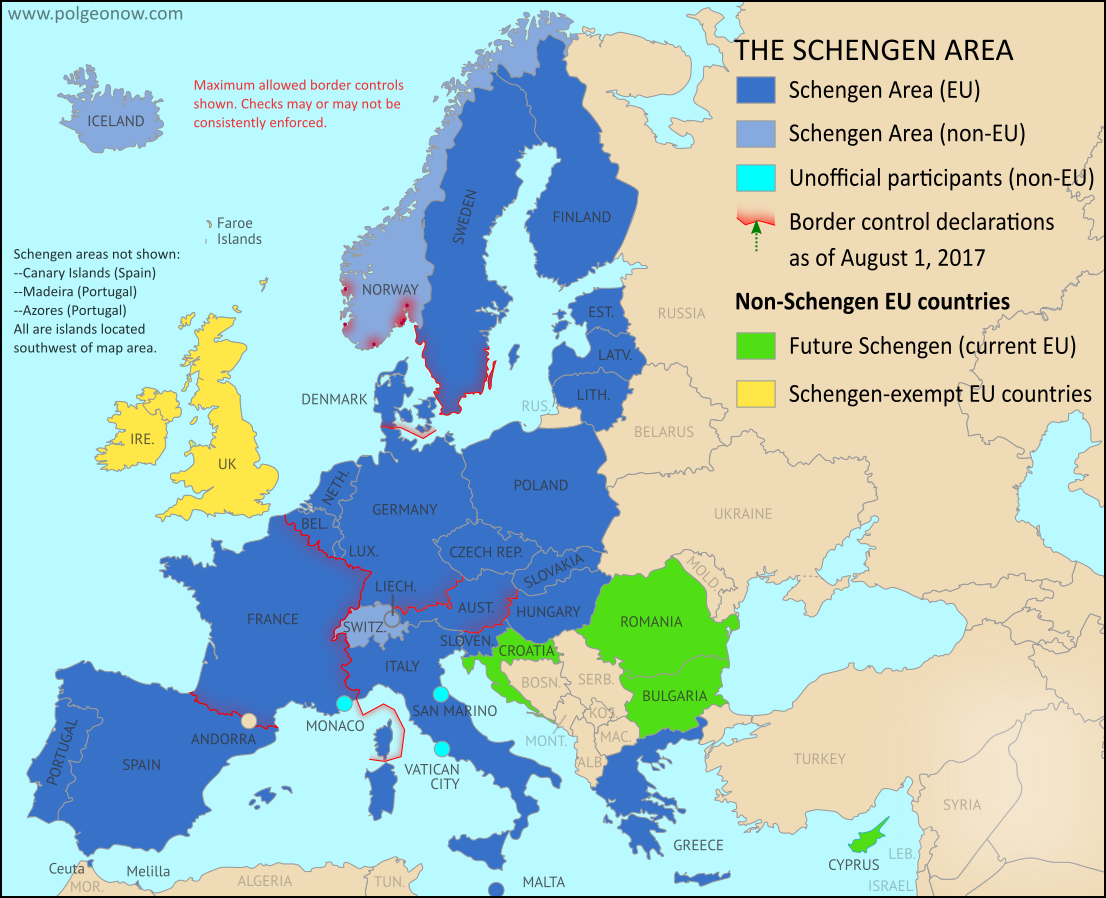Last year, we explained Europe's Schengen free travel area in plain English, then published maps of which European countries had temporarily reintroduced border controls as of March 2016, August 2016, and February 2017. Here's an update and summary for August of 2017.
 |
| Map by Evan Centanni, from blank map by Ssolbergj. License: CC BY-SA |
Current Border Controls Between Schengen Countries
As anyone who's visited Europe in recent decades knows, much of the continent is linked together as part of the "Schengen Area", a collection of countries that don't make travelers show any ID to cross back and forth across their borders (though this system is overseen by the European Union, the Schengen Area and the EU aren't the same thing). But the system does allow countries to temporarily reintroduce border controls under certain circumstances.With the spike in numbers of refugees and other immigrants arriving in Europe in the past two years, many Schengen countries have rushed to control the flow of people by using these special temporary exemptions. When we published our previous map of border controls within Schengen this past February, there were seven member countries reserving the right to perform border checks. Now there's one fewer, and the remaining six have renewed their declarations - perhaps for the last time.
It's important to note that the border controls shown on the map above are the maximum allowed under each country's declaration - actual enforcement may be extensive, limited, or even absent depending on the circumstances.
Learn More: The UK already isn't part of the Schengen Area or Eurozone, so what will change when it leaves the EU?
The 5 Schengen Countries with Negotiated Border Controls
 |
| The full EU and prospective members |
- Germany agreed to control only its border with Austria, ruling out border controls with Switzerland, the Czech Republic, Luxembourg, Belgium, the Netherlands, and Denmark.
- Austria agreed to control only its borders with Slovenia and Hungary, ruling out border controls with Italy, Switzerland, Liechtenstein, the Czech Republic, and Slovakia.
- Denmark agreed to control only its border with Germany (including land crossings and ferry connections), ruling out border control for arrivals from Sweden or Norway.
- Sweden agreed to control only crossings over the bridge from Denmark and sea arrivals along its western and southern coastline, ruling out controls for land borders with Norway and Finland or arrivals by sea along its east-central and northern coasts.
- Norway agreed to control only arrivals in ports with ferry connections to Sweden, Denmark, and Germany, ruling out controls along its land borders with Sweden and Finland.
In fact, Sweden had already announced just before the extension that it would be ending some border checks for travelers arriving from Denmark; but the announcement said other types of checks would continue, and the country did go ahead and notify the EU that it would accept the extension to November.
France's Border Controls Extended for the Fifth Time
Unlike most of the countries with temporary border checks, which have focused their controls on specific stretches of borders popular with refugees and other migrants, France has reserved the right to maintain controls on all its borders - except, presumably, the boundary with tiny Monaco, which for immigration control purposes is already treated like part of France.Unlike other countries with border checks, France's controls are justified mostly as an anti-terrorism measure, not as a way of keeping out migrants. The French border controls were first declared in 2015 and have been in place ever since then due to several extensions:
| Start Date | Duration | Stated Reason |
| Nov. 13, 2015* | 1 month | Paris Climate Change Conference |
| Dec. 14, 2015 | 6 months, 12 days | "emergency state as introduced further to Paris attacks" |
| May 27, 2016 | 2 months | Euro 2016 and Tour de France |
| July 26, 2016 | 6 months | "emergency state as introduced further to Nice attack" |
| Jan. 27, 2017 | 5 months, 18 days | "persistent terrorist threat" |
| July 16, 2017 | 3 months, 15 days | "persistent terrorist threat" |
*France's November-December 2015 border controls were only for air and land borders (sea ports were excluded)
The most recent extension, posted on the EU's Schengen website but apparently not reported in the English-language media, expires after October 31. This is probably part of newly elected President Emmanuel Macron's plans to extend the country's overall state of emergency, though Macron does say he believes in preserving Schengen's free-travel principles in the long run. That attitude stands in contrast to his defeated opponent for the presidency, Marine Le Pen, who had promised to suspend all participation in Schengen while also preparing for a vote on leaving the EU.
Temporary Border Controls in Malta, Portugal, Italy, and Germany
At the time of our last Schengen border control map report, the tiny island country of Malta had also declared temporary border checks as a security precaution while the country was hosting two important political summits related to migration into Europe. Those checks lasted for just twenty days, expiring after February 9.Since then, Portugal also announced temporary border controls, for security during a visit by the Pope (May 10-14), and Italy did the same when hosting a G7 summit (May 10-30). Germany also reserved the right to enforce controls on all its borders - not just with Austria - from May 15 to July 9 while it prepared to host the G20 financial summit.
These truly temporary suspensions of free travel are a normal part of the Schengen system, and all three countries have since let the declared controls expire.
Learn More:
Which Countries Are in the Schengen Area, and Which EU Countries Aren't?
Map of Temporary Schengen Border Controls in March 2016
Map of Temporary Schengen Border Controls in August 2016
Map of Temporary Schengen Border Controls in February 2017
